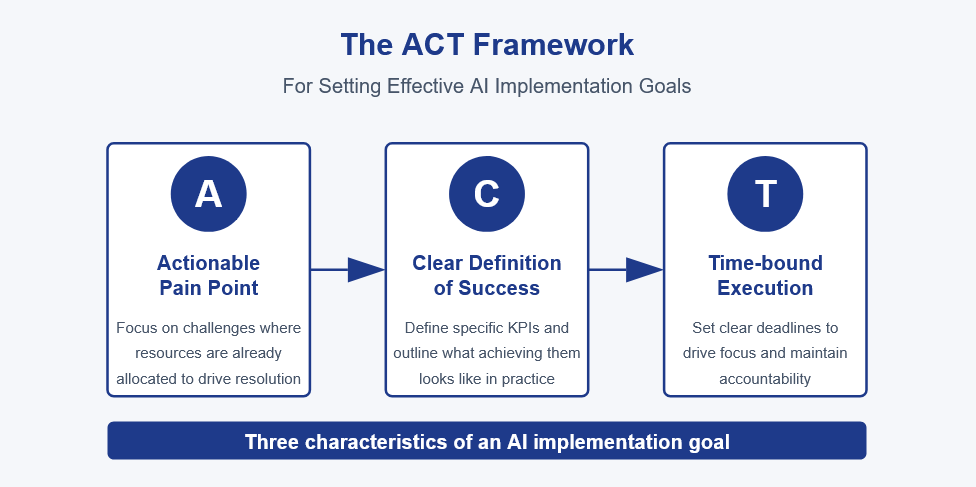MAINSTREET CHAMPIONS PT 3
“This nation should commit itself to achieving the goal, before this decade is out, of landing a man on the moon and returning him safely to earth” – John F Kennedy.
Following the launch of Sputnik, the first satellite to orbit earth in 1957, Kennedy understood the urgency of the space movement and recognized that to maintain the US’s military supremacy and preserve its national security, he had to embrace space technology. However, instead of rushing into action blindly, he did something powerful – he stood before a joint session of congress on May 25th, 1961, and declared that the US would land a man on the moon and bring them back home safely by the end of the decade.
What made this goal effective wasn’t just that it was audacious, but that it addressed a clear problem, defined what success would look like, and set a strict deadline to drive focus and accountability.
Small businesses today are facing their sputnik moment. AI is changing the competitive landscape and shifting the balance of power. Small businesses today can operate as a big business many times their size by leveraging AI. It was clear to Kennedy in 1961 that if the US didn’t embrace space technology, it was going to fall behind. Similarly, small business owners today must embrace AI to stay ahead. But embracing AI isn’t just about using the latest shiny tool. To see real ROI, businesses must set a clear, strategic goal for AI implementation.
Small business owners can learn a lot from Kennedy’s speech in setting their goals. I believe an effective AI implementation goal that can drive ROI for the organization must have three characteristics;
- A – An actionable pain point
- C – Clear definition of what success should look like
- T – Time bound execution to drive focus and accountability
ACT Your Goals
Last week, we discussed why small business owners must first map out their customer or operational journey to uncover real pain points. This step is crucial before setting any AI implementation goal. In my conversations with small business owners, I’ve noticed a pattern—those who see the most success with AI follow a specific approach to goal setting. This insight led to the ACT framework, a simple yet effective way to develop AI goals that drive real impact.
The first pillar of the ACT framework is ensuring that the goal addresses an actionable pain point. This principle was evident in Kennedy’s moonshot. The pain point—America’s lag in space exploration—was clear, but what made it actionable was Kennedy’s commitment to mobilizing resources and launching a tangible project - the Apollo Program. Similarly, in business, not all pain points warrant AI intervention. Business owners must focus on challenges where labor and capital resources have already been allocated to drive a resolution.
Consider a fitness studio evaluating AI adoption. The business might face multiple pain points—inefficient content creation, poor lead conversion, or high customer churn. However, not all of these are actionable. If the studio has already invested in a consultant to improve lead conversion, that becomes the most actionable pain point. Since there is an active project with a defined ROI, the investment in AI implementation can be aligned with the effort to optimize the ROI. This approach ensures AI adoption is strategic rather than arbitrary, directing efforts toward a clearly defined initiative.
The second pillar of the ACT framework is a clear and specific definition of success. Kennedy could have simply stated that the U.S. aimed to land on the moon, but that would have been vague. Instead, he made the goal unmistakable, landing a man on the moon and returning him safely to Earth. This level of clarity not only sets a concrete objective but also made it possible to measure success. Similarly, business owners must define success in precise terms to effectively gauge the impact of AI implementation.
To do this, businesses should define a measurable key performance indicator (KPI) and outline what achieving it would look like in practice. Consider the fitness studio example. A well-defined AI goal might be to increase the conversion rate of first-time leads to booked classes by 15% and, as a result, drive higher class attendance. So, by pairing a clear measurable KPI with its real-world manifestation, AI implementation becomes both measurable and actionable, ensuring it delivers the intended ROI.
The last pillar is ensuring time-bound execution to drive focus and accountability. Without a clear deadline, AI initiatives risk becoming indefinite experiments rather than strategic improvements. Setting a defined time frame forces prioritization, ensuring that AI is implemented with urgency and that its impact can be assessed within a meaningful window.
Small business owners can unlock the true value of AI by ensuring it is not just a cost on the income statement but a strategic investment that drives measurable ROI. To achieve this, businesses should apply the ACT framework to set a clear AI goal and take decisive action to implement it effectively.
THIS WEEK ON MAINSTREET
📰Mainstreet Minute:
No major developments to report this week. We'll be back with fresh insights in our next update.
📌Quick Win Tip:
Letterly, is an AI tool that let’s you turn your voice into anything. You can simply record your unstructured thoughts in more than 90 languages and letterly will create a polished and structured text that you can use for to send an email, create a journal entry, write a blog, or make a list. Get a quick win this week and reply to your next email with letterly by simply telling it your thoughts.








